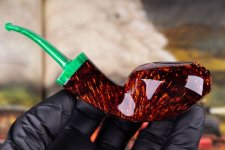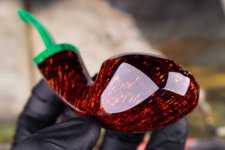You make tens of thousands of these a year and you figure it out.
Speaking only to the top British makers, there were a number of steps involved in getting to what was considered a "flawless smooth". It involved very careful shaping, sometimes going through a "cut down" stage to remove minor imperfections while retaining the pattern shape, several steps of papering, then staining, then more smoothing, and sometimes an application of gum arabic to fill in the minute variations left in the surface, before applying a final wax.
This is sort of a French made counterfeit of a real Charatan.
The too glossy and too perfect “grain” gives it away as a cheap pipe.
View attachment 276014
View attachment 276015
And a couple of years ago there was this guy selling $200 geniune SON pipes that Eric Nording made before he was old enough to shave, as part of a business dispute with his first partner. Mine only cost $30 because it was a second. Such a deal. It even takes a 9mm filter and came pre carbonized.
View attachment 276013
And that same seller was peddling $30 Lorenzetti Buyere Extra pipes, but smoked only once. They take 9mm filters and are pre carbonized too.
View attachment 276018View attachment 276019
But this old Weber Golden Wanut is the real coin. This outrageous finish is real, on top of real, flawless flame grain. And you can tell the real one from the modern too good to be true pipes in a glance.
View attachment 276022View attachment 276023
View attachment 276024View attachment 276025
The three Pete Killarney pipes I bought for sixty bucks got so hot they nearly were unsmokable. I spent a couple of days stripping one and then it was an ugly, plain hot smoker. The other two have cured out stored in a milk barn for thirty years and are decent smokers today.
But there’s a shortcut to outrageous finish.
It involves bowling ball varnish and clever staining.
The other new super finish pipes I have are good smokers, not they’ll wake up Marxmans tomorrow, but for aromatics nobody will ever complain.
That Weber is a dynamite smoker, none better.
And strangely, the Nording seems as good as a non Algerian briar pipe gets, too.
How do they mass produce too perfect pipes?











